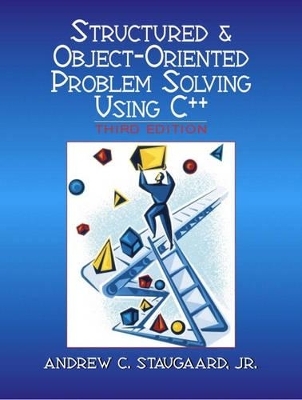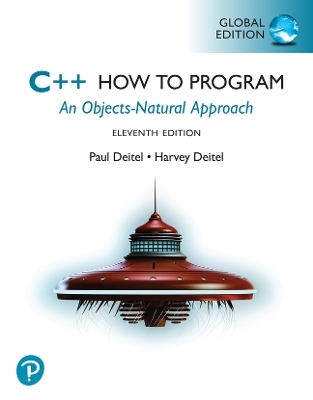
Structured & Object-Oriented Problem Solving Using C++
Pearson
978-0-13-028451-8 (ISBN)
- Titel erscheint in neuer Auflage
- Artikel merken
Appropriate for Introductory Computer Science (CS1) courses using C++ and Introductory C++ programming courses found in Computer Science, Engineering, CIS, MIS, and Business Departments.
This accessible text emphasizes problem-solving techniques using the C++ language, with coverage that develops strong problem-solving skills using problem abstraction and stepwise refinement through the “Programmer's Algorithm.” Staugaard first emphasizes the structured (procedural) paradigm, then gradually advances to the object-oriented paradigm—using object-oriented programming “seed topics.” This approach prepares students for in-depth coverage of classes and objects presented later in the text, while building essential structured programming concepts.
(NOTE: Each chapter begins with Chapter Objectives and Introduction and concludes with Chapter Summary and Questions and Problems.)
1. Getting Acquainted with Computers, Programs, and C++.
The Hardware. Programming and Software. Getting Started with C++: “hello world.”
2. Problem Solving, Abstraction, and Stepwise Refinement.
The Programmer's Algorithm. Problem Solving Using Algorithms. Problem Abstraction and Stepwise Refinement. Problem Solving in Action: Sales Tax. Problem Solving in Action: Pythagorean Theorem. Problem Solving in Action: Credit Card Interest.
3. Data: Types, Classes, and Objects.
The Idea of Data Abstraction and Classes. The Primitive Data Types in C++. Constants and Variables. Strings. Enumerated Data. Problem Solving in Action: Bank Account Processing.
4. Input and Output Objects.
Getting Stuff Out. Getting Stuff In. Reading and Writing Disk Files. Problem Solving in Action: User-Friendly Programs.
GUI 101: Simple Windows I/O.
5. Nuts and Bolts: Standard Stuff in C++.
Arithmetic Operators. Assignment Operators. Some Standard Functions in C++. Problem Solving in Action: Inventory Control. Problem Solving in Action: Data Communications. Problem Solving in Action: A Technical Challenge: Polar and Rectangular Coordinates.
Graphics 101: Simple Graphics.
6. Decisions, Decisions, Decisions.
Boolean Operators. Problem Solving in Action: Boolean Logic. The if Statement. The if/else Statement. Nested ifs. The switch Statement. Problem Solving in Action: Menu-Driven Programs.
SE101: Software Engineering: History and Overview.
7. Looping Operations: Iteration.
The while Loop. The do/while Loop. The for Loop. The break and continue Options. Problem Solving in Action: Parallel Resistor Circuit Analysis.
SE102: Software Paradigms.
8. Functions In-Depth.
Non-Void Functions. Void Functions. Function Prototypes. Problem Solving in Action: Programming with Functions. Scoptin-Out Variables and Constants—Block Structure. Problem Solving in Action: Programming with Functions. Recursion.
SE103: The Structured Paradigm.
9. One-Dimensional Arrays.
The Structure of an Array. Defining One-Dimensional Arrays in C++. Accessing Arrays. Arrays of Characters: C-Strings. Passing Arrays and Array Elements to Functions. Problem Solving in Action: Searching an Array Using Sequential Search. Problem Solving in Action: Sorting an Array Using Insertion Sort. Problem Solving in Action: Searching an Array Using Recursion (Binary Search). The STL Vector Class.
10. Classes and Objects In-Depth.
Classes and Objects. Member Functions. Problem Solving in Action: Building Programs Using Classes and Objects. Multifile Program Construction. Problem Solving in Action: Building a Multi-File C++ Program.
SE104: The Object-Oriented Paradigm Using UML.
11. Class Inheritance.
Why Use Inheritance? Declaring and Using Derived Classes. Polymorphism and Dynamic Binding.
12. File I/O.
Fundamental Concepts and Ideas. Accessing File Information.
13. Pointers.
The Idea of Pointers. Defining Pointers and Initializing Pointer Data. Accessing Pointer Data and Pointer Arithmetic. Arrays of Pointers …® Indirection. Using Points as Function Arguments and Parameters. Object Pointers.
14. Introduction to Data Structures and ADTs.
The Concept of Data Abstraction Revisited. The Stack ADT. The Queue ADT. The List ADT. The Standard Template Library, or STL.
15. Multidimensional Arrays.
Two-Dimensional Arrays. Arrays of More Than Two Dimensions.
Appendix A: Quick-Check Solutions.
Appendix B: ASCII Character Table.
Appendix C: Visual Studio Tutorial.
Introduction. Jump Right In: A Visual Studio Overview. Dealing with Errors in Visual C++. Visual C++ Projects. Visual C++ Specific Comments. Conclusion.
Appendix D: C++ Quick Reference with STL.
Keywords. Conversion Functions. Math Functions (math.h). STL list Class Function. STL stack Class Functions. String Class Operations. STL queue Class Functions. STL vector Class Functions.
Glossary.
Index.
| Erscheint lt. Verlag | 31.5.2001 |
|---|---|
| Sprache | englisch |
| Maße | 178 x 233 mm |
| Gewicht | 1256 g |
| Themenwelt | Mathematik / Informatik ► Informatik ► Programmiersprachen / -werkzeuge |
| ISBN-10 | 0-13-028451-3 / 0130284513 |
| ISBN-13 | 978-0-13-028451-8 / 9780130284518 |
| Zustand | Neuware |
| Informationen gemäß Produktsicherheitsverordnung (GPSR) | |
| Haben Sie eine Frage zum Produkt? |
aus dem Bereich
